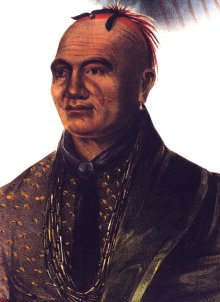

The Mohawk Indian chief Joseph Brant served as a spokesman for his people, a Christian missionary of the Anglican church, and a British military officer during the U.S. War of Independence. He is remembered for his efforts in unifying upper New York Indian tribes and leading them in terrorizing raids against patriot communities in support of Great Britain's efforts to repress the rebellion. He is also credited for the establishment of the Indian reservation on the Grand River in Canada where the neighboring town of Brantford, Ontario, bears his name.
Brant was born in 1742 on the banks of the Ohio River and given the Indian name of Thayendanegea, meaning "he places two bets." He inherited the status of Mohawk chief from his father. He attended Moor's Charity School for Indians in Lebanon, Connecticut, where he learned to speak English and studied Western history and literature. He became an interpreter for an Anglican Missionary, the Reverend John Stuart, and together they translated the prayer book and the Gospel of Mark into Mohawk. Molly Brant, Joseph's sister, married General Sir William Johnson who was the British superintendent for northern Indian affairs. Sir William was called to duty during the last French and Indian War of 1754-1763. Joseph followed Sir William into battle at the age of 13, along with the other Indian braves at the school.
Around 1768 he married Christine, the daughter of an Oneida chief, whom he had met in school. They had both Indian and Anglican wedding ceremonies and lived on a farm which Joseph had inherited. Christine died of tuberculosis around 1771, leaving Joseph with a son and a daughter. During this time, Joseph resumed his religious work, translating the Acts of the Apostles into the Mohawk language. In 1773, he married Susannah, sister of his first wife. Susannah died a few months later, also of tuberculosis. In 1774 he was appointed secretary to Sir William's successor, Guy Johnson. In 1775 he received a captain's commission and was sent to England to assess whether the British would or would not help the Mohawk recover their lands. He met with the King on two occasions and a dinner was held in his honor.
On his return to the colonies, he saw action in the Battle of Long Island in August 1776. He led four of the six nations of the Iroquois League in attacks against colonial outposts on the New York frontier. Brant commanded the Indians in the Battle of Oriskany on August 6, 1777. In early 1778 he gathered a force of Indians from the villages of Unadilla and Oquaga on the Susquehanna River. On September 17, 1778 they destroyed German Flats near Herkimer, New York.
Around 1782, Brant married his third wife, Catherine Croghan, daughter of an Irishman and a Mohawk. With the war over, and the British having surrendered lands to the colonists and not to the Indians, Brant was faced with finding a new home for himself and his people. He discouraged further Indian warfare and helped the U.S. commissioners to secure peace treaties with the Miami's and other tribes. He retained his commission in the British Army and was awarded a grant of land on the Grand River in Ontario by Governor Sir Frederick Haldimand of Canada in 1784. The tract of 675,000 acres encompassed the Grand River from its mouth to its source, six miles deep on either side.
